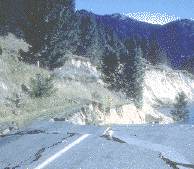
This exercise is worth a total of 30 points and will be handed in on April 28, 2001 when you take exam 3.
Background
The velocity of a P or S wave is a function of the physical properties of the rock the wave is traveling through. Different rocks have different physical characteristics (such as how compressible they are and how the respond to shear stresses) and different P and S wave velocities. In fact, if the velocity of the wave can be measured, it may be possible to predict the type of rock the wave traveled through - indirect detection of rock type!
The velocity of a P wave can be expressed as:
As the pressure increases (increasing depth of travel) the quantity (B+G) increases faster than Density. Therefore, with increasing depth we expect the velocity of the P wave to increase.
HOWEVER, if the wave passes from one material to another, the wave may speed up, slow down or not change velocity or direction, depending on the contrast in properties of the two types of material.
Each day new Earthquakes are plotted at the Earthquake Locator . Another good resource for recent earthquakes is provided by IRIS
Starting on March 27, 2001, select the 20 most recent earthquakes of magnitude 5.0 and higher. Prepare a table with columns for:
| Location of Epicenter | Focal Depth | Magnitude | Remarks |
|---|
On Shaking Ground is a similar exercise that may give you some ideas.
Prepare a copy of the map of plate boundaries and locate the epicenters of these 20 most recent magnitude 5 or higher events in red. Record the magntude and depth to the focus (if it is given) for each event in your table.
Plate Tectonics - The Cause of Earthquakes is a very good introduction to earthquakes and plate tectonics. Read through this section for a general review. Read the following section on Seismic Waves. Finish you reading by quickly going through the section on Richter Magnitude. Don't get bogged down in the mathematics. Focus on differences between Richter's scale and the older Mercalli scale.
a Letter to an Editor
You live in the Cascades area. In recent editorials the regional planners have written articles about how much the new Cascades Convention Center will add to the regional economy. You believe that these writers have confused the public about the frequency and magnitude of events in the Cascades. Write a 300 word (or so) letter to the editor in which you state your opinion as to the safety of such a facility. How likely are earthquakes in this area? Use the information you have gathered to formulate your letter.
In your own words, describe the Richter scale and the Mercalli scale for describing earthquakes. Include the distinction between Intensity and Magnitude.
What are some of the problems with using the Mercalli scale? How do the users of this scale counter these criticisms?
The Table and Map and editorial that you complete for this exercise will be handed in on the day of exam 3.
| jbutler@uh.edu
|E-mail the ClassListserv|Read the ClassListserv|
|Textbook Home Page
|Glossary of Geologic Terms|Search These Pages|
|Other Courses|Resources|Grade Book|
Return to the Physical Geology Home Page
Copyright by John C. Butler, July 29, 1995